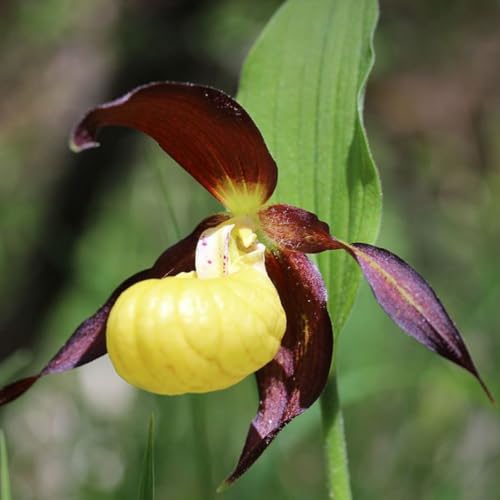naoki
Well-Known Member
I happened to see this fairly recent paper:
Mou Zong-min, Yan Ning, Li Shu-yun and Hu Hong, 2012. Nitrogen Requirements for Vegetative Growth, Flowering, Seed Production, and Ramet Growth of Paphiopedilum armeniacum (Orchid). HortScience May 2012 vol. 47(5): 585-588
Only abstract is available (but PM me if you want to take a look).
Well, there aren't so many nutrition studies which use our favorite group of orchids, so I thought that some of you might be interested in. I describe a summary of interesting aspects.
Culture:
- Sphagnum moss in 4" pot.
- 24/18C
- Fertilizer: Hogland and Arnon (1950), 50ml/pot, once a month.
- water as needed
Treatment:
- Nitrogen: 0, 105, 210, 420 mg/L (=ppm) (I'm not sure NO3 or NH4).
- Started in Nov, and ends in Aug next year (short-term experiment)
- sample size: total of 360x 3 year old seedlings to study vegetative growth, and 200x 5 year old flowering plants to study sexual and clonal reproduction.
Results:
1. Effects on sexual reproduction:
- The flower lasts longer with low N (28 days with 0N vs 21 days with 420ppmN)
- petal diameter is largest with 210ppmN
- 210ppmN plants produced largest fruits, and the germination rate of the seeds were much higher (22% vs 2-3% for the other ppm)
- The quality of seeds under higher N is much better. In other words, the seedlings derived from seeds produced by higher N moms grow better in flask (measurement taken for 6-month old seedlings in the flask). Dry weight of a 6-mo seedling: 6.53, 7.21, 13.12, 23.32mg (from 0N to 420ppmN). I'm really surprised to see such a big difference.
2. Effects on vegetative clonal reproduction:
- The mom under 105ppmN produced the largest new growth (58% larger than 420ppmN).
3. Effects on growth of seedlings:
- under low N, more lower leaves die, and slightly more new leaves are produced (only the highest N produced significantly less leaves), so high leaf turn over rate.
- But overall increase in leaf area is higher with more N
- higher N and chlorophyll concentration in 210&420ppm
Well, high N is usually associated with more vegetative growth at least for the short-term (this is shown many times in orchids). So that part wasn't so interesting. But I thought that it is very cool to see the dramatic effects of N on reproduction. High N plants make better kids by sexual reproduction, but low N plants appear to shift the resource toward asexual reproduction. Orchid seeds are tiny, and they don't appear to put much resources (no endosperms). But the nutrient status of the parent has dramatic influence on the quality of kids.
Since their culture is quite different from how most of us grow paphs (in the US), the absolute N concentration is not directly applicable for us.
Mou Zong-min, Yan Ning, Li Shu-yun and Hu Hong, 2012. Nitrogen Requirements for Vegetative Growth, Flowering, Seed Production, and Ramet Growth of Paphiopedilum armeniacum (Orchid). HortScience May 2012 vol. 47(5): 585-588
Only abstract is available (but PM me if you want to take a look).
Well, there aren't so many nutrition studies which use our favorite group of orchids, so I thought that some of you might be interested in. I describe a summary of interesting aspects.
Culture:
- Sphagnum moss in 4" pot.
- 24/18C
- Fertilizer: Hogland and Arnon (1950), 50ml/pot, once a month.
- water as needed
Treatment:
- Nitrogen: 0, 105, 210, 420 mg/L (=ppm) (I'm not sure NO3 or NH4).
- Started in Nov, and ends in Aug next year (short-term experiment)
- sample size: total of 360x 3 year old seedlings to study vegetative growth, and 200x 5 year old flowering plants to study sexual and clonal reproduction.
Results:
1. Effects on sexual reproduction:
- The flower lasts longer with low N (28 days with 0N vs 21 days with 420ppmN)
- petal diameter is largest with 210ppmN
- 210ppmN plants produced largest fruits, and the germination rate of the seeds were much higher (22% vs 2-3% for the other ppm)
- The quality of seeds under higher N is much better. In other words, the seedlings derived from seeds produced by higher N moms grow better in flask (measurement taken for 6-month old seedlings in the flask). Dry weight of a 6-mo seedling: 6.53, 7.21, 13.12, 23.32mg (from 0N to 420ppmN). I'm really surprised to see such a big difference.
2. Effects on vegetative clonal reproduction:
- The mom under 105ppmN produced the largest new growth (58% larger than 420ppmN).
3. Effects on growth of seedlings:
- under low N, more lower leaves die, and slightly more new leaves are produced (only the highest N produced significantly less leaves), so high leaf turn over rate.
- But overall increase in leaf area is higher with more N
- higher N and chlorophyll concentration in 210&420ppm
Well, high N is usually associated with more vegetative growth at least for the short-term (this is shown many times in orchids). So that part wasn't so interesting. But I thought that it is very cool to see the dramatic effects of N on reproduction. High N plants make better kids by sexual reproduction, but low N plants appear to shift the resource toward asexual reproduction. Orchid seeds are tiny, and they don't appear to put much resources (no endosperms). But the nutrient status of the parent has dramatic influence on the quality of kids.
Since their culture is quite different from how most of us grow paphs (in the US), the absolute N concentration is not directly applicable for us.












































